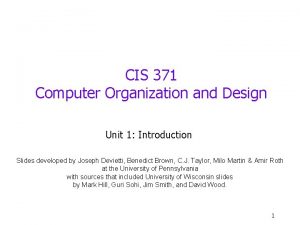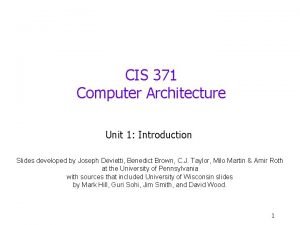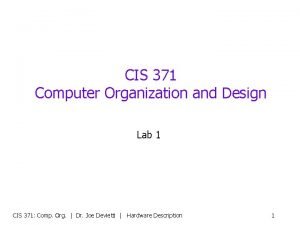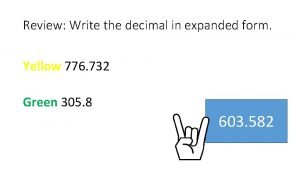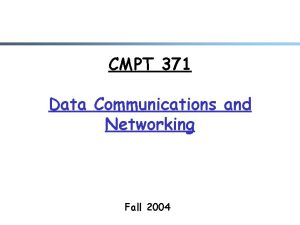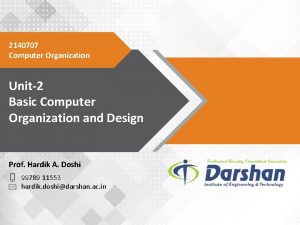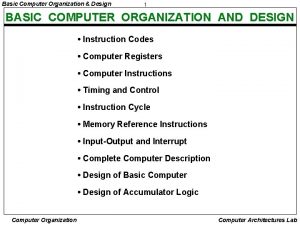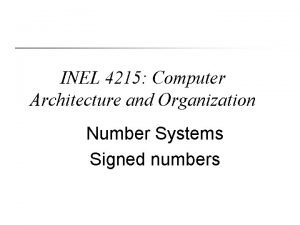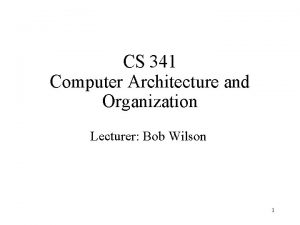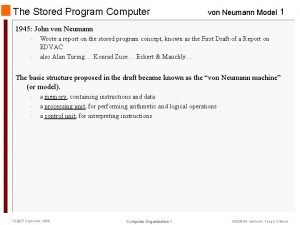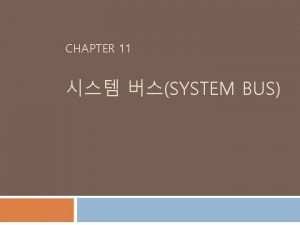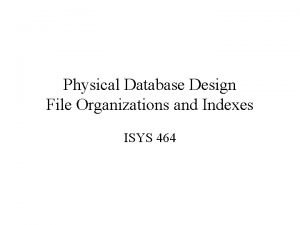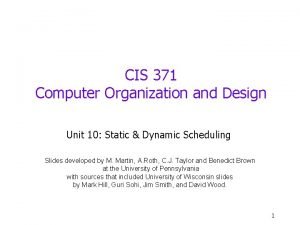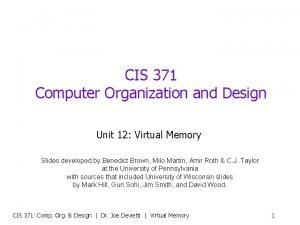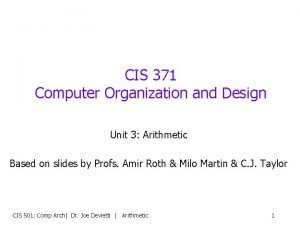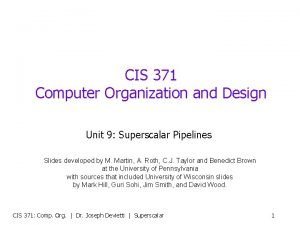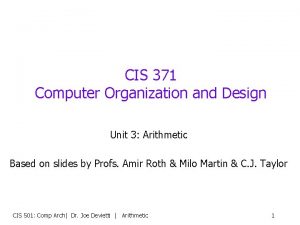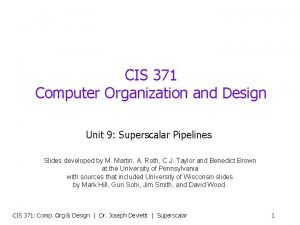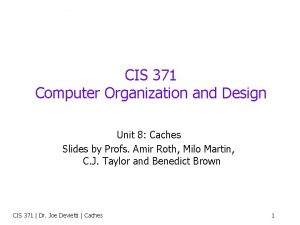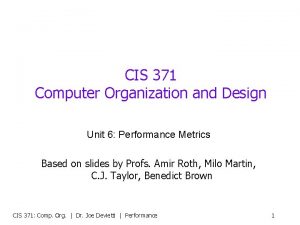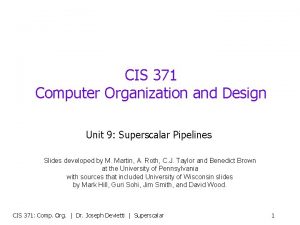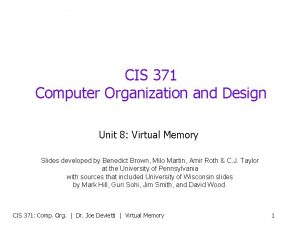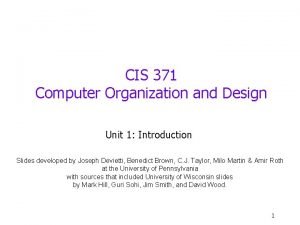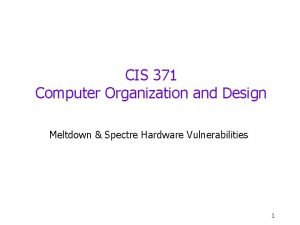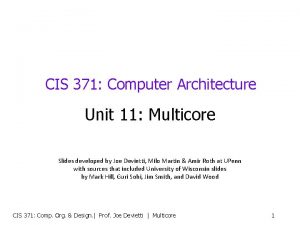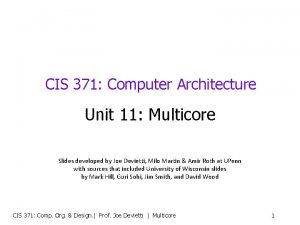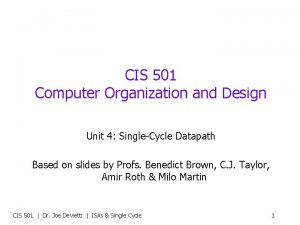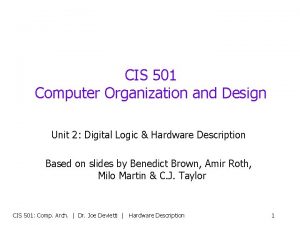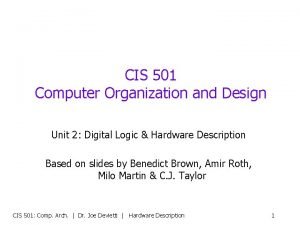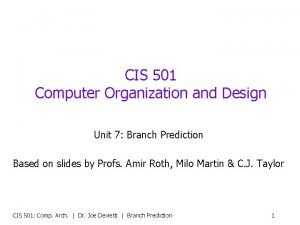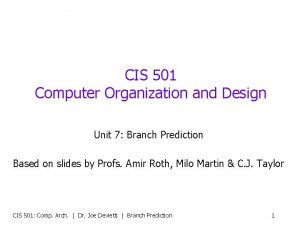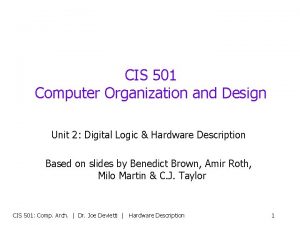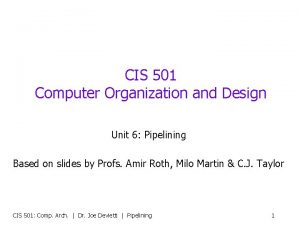CIS 371 Computer Organization and Design Unit 6































- Slides: 31

CIS 371 Computer Organization and Design Unit 6: Performance Metrics Based on slides by Profs. Amir Roth, Milo Martin, C. J. Taylor, Benedict Brown CIS 371: Comp. Org. | Dr. Joe Devietti | Performance 1

This Unit App App System software Mem CPU I/O • Metrics • Latency and throughput • Speedup • Averaging • CPU Performance • Performance Pitfalls • Benchmarking CIS 371: Comp. Org. | Dr. Joe Devietti | Performance 2

Readings • P&H • Revisit Chapter 1. 4, 1. 8, 1. 9 CIS 371: Comp. Org. | Dr. Joe Devietti | Performance 3

Reasoning About Performance CIS 371: Comp. Org. | Dr. Joe Devietti | Performance 4

Performance: Latency vs. Throughput • Latency (execution time): time to finish a fixed task • Throughput (bandwidth): number of tasks in fixed time • Different: exploit parallelism for throughput, not latency (e. g. , bread) • Often contradictory (latency vs. throughput) • Will see many examples of this • Choose definition of performance that matches your goals • Scientific program? latency. web server? throughput. • Example: move people 10 miles • • Car: capacity = 5, speed = 60 miles/hour Bus: capacity = 60, speed = 20 miles/hour Latency: car = 10 min, bus = 30 min Throughput: car = 15 PPH (count return trip), bus = 60 PPH • Fastest way to send 10 TB of data? (1+ gbits/second) CIS 371: Comp. Org. | Dr. Joe Devietti | Performance 5

Amazon Does This… CIS 371: Comp. Org. | Dr. Joe Devietti | Performance 6

Comparing Performance - Speedup • A is X times faster than B if • X = Latency(B) / Latency(A) (divide by the faster) • X = Throughput(A) / Throughput(B) (divide by the slower) • A is X% faster than B if • Latency(A) = Latency(B) / (1+X/100) • Throughput(A) = Throughput(B) * (1+X/100) • Car/bus example • Latency? Car is 3 times (and 200%) faster than bus • Throughput? Bus is 4 times (and 300%) faster than car CIS 371: Comp. Org. | Dr. Joe Devietti | Performance 7

Speedup and % Increase and Decrease • Program A runs for 200 cycles • Program B runs for 350 cycles • Percent increase and decrease are not the same. • % increase: ((350 – 200)/200) * 100 = 75% • % decrease: ((350 - 200)/350) * 100 = 42. 3% • Speedup: • 350/200 = 1. 75 – Program A is 1. 75 x faster than program B • As a percentage: (1. 75 – 1) * 100 = 75% • If program C is 1 x faster than A, how many cycles does C run for? – 200 cycles (the same as A) • What if C is 1. 5 x faster? 133 cycles (50% faster than A) CIS 371: Comp. Org. | Dr. Joe Devietti | Performance 8

Mean (Average) Performance Numbers • Arithmetic: (1/N) * ∑P=1. . N Latency(P) • For units that are proportional to time (e. g. , latency) • Harmonic: N / ∑P=1. . N 1/Throughput(P) • For units that are inversely proportional to time (e. g. , throughput) • You can add latencies, but not throughputs • Latency(P 1+P 2, A) = Latency(P 1, A) + Latency(P 2, A) • Throughput(P 1+P 2, A) != Throughput(P 1, A) + Throughput(P 2, A) • 1 mile @ 30 miles/hour + 1 mile @ 90 miles/hour • Average is not 60 miles/hour • Geometric: N√∏P=1. . N Speedup(P) • For unitless quantities (e. g. , speedup ratios) CIS 371: Comp. Org. | Dr. Joe Devietti | Performance 9

Harmonic Mean Example • You drive two miles • 30 miles per hour for the first mile • 90 miles per hour for the second mile • Question: what was your average speed? • • • Hint: the answer is not 60 miles per hour 0. 03333 hours per mile for 1 mile 0. 01111 hours per mile for 1 mile 0. 02222 hours per mile on average = 45 miles per hour CIS 371: Comp. Org. | Dr. Joe Devietti | Performance 10

Mean (Average) Performance Numbers • Arithmetic: (1/N) * ∑P=1. . N Latency(P) • For units that are proportional to time (e. g. , latency) • Harmonic: N / ∑P=1. . N 1/Throughput(P) • For units that are inversely proportional to time (e. g. , throughput) • You can add latencies, but not throughputs • Latency(P 1+P 2, A) = Latency(P 1, A) + Latency(P 2, A) • Throughput(P 1+P 2, A) != Throughput(P 1, A) + Throughput(P 2, A) • 1 mile @ 30 miles/hour + 1 mile @ 90 miles/hour • Average is not 60 miles/hour • Geometric: N√∏P=1. . N Speedup(P) • For unitless quantities (e. g. , speedup ratios) CIS 371: Comp. Org. | Dr. Joe Devietti | Performance 11

CPU Performance CIS 371: Comp. Org. | Dr. Joe Devietti | Performance 12

Recall: CPU Performance Equation • Multiple aspects to performance: helps to isolate them • Latency = seconds / program = • (insns / program) * (cycles / insn) * (seconds / cycle) • Insns / program: dynamic insn count • Impacted by program, compiler, ISA • Cycles / insn: CPI • Impacted by program, compiler, ISA, micro-arch • Seconds / cycle: clock period (Hz) • Impacted by micro-arch, technology • For low latency (better performance) minimize all three – Difficult: often pull against one another CIS 371: Comp. Org. | Dr. Joe Devietti | Performance 13

Cycles per Instruction (CPI) • CPI: Cycle/instruction for on average • IPC = 1/CPI • Used more frequently than CPI • Favored because “bigger is better”, but harder to compute with • Different instructions have different cycle costs • E. g. , “add” typically takes 1 cycle, “divide” takes >10 cycles • Depends on relative instruction frequencies • CPI example • • A program executes equal: integer, floating point (FP), memory ops Cycles per instruction type: integer = 1, memory = 2, FP = 3 What is the CPI? (33% * 1) + (33% * 2) + (33% * 3) = 2 Caveat: this sort of calculation ignores many effects • Back-of-the-envelope arguments only CIS 371: Comp. Org. | Dr. Joe Devietti | Performance 14

CPI Example • Assume a processor with instruction frequencies and costs • • Integer ALU: 50%, 1 cycle Load: 20%, 5 cycle Store: 10%, 1 cycle Branch: 20%, 2 cycle • Which change would improve performance more? • A. Pipeline change to reduce branch cost to 1 cycle? • B. Faster data memory to reduce load cost to 3 cycles? • Compute CPI • Base = 0. 5*1 + 0. 2*5 + 0. 1*1 + 0. 2*2 = 2 CPI • A = 0. 5*1 + 0. 2*5 + 0. 1*1+ 0. 2*1 = 1. 8 CPI (1. 11 x or 11% faster) • B = 0. 5*1 + 0. 2*3 + 0. 1*1 + 0. 2*2 = 1. 6 CPI (1. 25 x or 25% faster) • B is faster CIS 371: Comp. Org. | Dr. Joe Devietti | Performance 15

Measuring CPI • How are CPI and execution-time actually measured? • Execution time? stopwatch timer (Unix “time” command) • CPI = (CPU time * clock frequency) / dynamic insn count • How is dynamic instruction count measured? • More useful is CPI breakdown (CPICPU, CPIMEM, etc. ) • So we know what performance problems are and what to fix • Hardware event counters • Available in most processors today • One way to measure dynamic instruction count • Calculate CPI using counter frequencies / known event costs • Cycle-level micro-architecture simulation + Measure exactly what you want … and impact of potential fixes! • Method of choice for many micro-architects CIS 371: Comp. Org. | Dr. Joe Devietti | Performance 16

Pitfalls of Partial Performance Metrics CIS 371: Comp. Org. | Dr. Joe Devietti | Performance 17

Mhz (Mega. Hertz) and Ghz (Giga. Hertz) • 1 Hertz = 1 cycle per second 1 Ghz is 1 cycle per nanosecond, 1 Ghz = 1000 Mhz • (Micro-)architects often ignore dynamic instruction count… • … but general public (mostly) also ignores CPI • Equates clock frequency with performance! • Which processor would you buy? • Processor A: CPI = 2, clock = 5 GHz • Processor B: CPI = 1, clock = 3 GHz • Probably A, but B is faster (assuming same ISA/compiler) • Classic example • 800 MHz Pentium. III faster than 1 GHz Pentium 4! • More recent example: Core i 7 faster clock-per-clock than Core 2 • Same ISA and compiler! • Meta-point: danger of partial performance metrics! CIS 371: Comp. Org. | Dr. Joe Devietti | Performance 18

MIPS (performance metric, not the ISA) • (Micro) architects often ignore dynamic instruction count • Typically work in one ISA/one compiler treat it as fixed • CPU performance equation becomes • Latency: seconds / insn = (cycles / insn) * (seconds / cycle) • Throughput: insn / second = (insn / cycle) * (cycles / second) • MIPS (millions of instructions per second) • Cycles / second: clock frequency (in MHz) • Example: CPI = 2, clock = 500 MHz 0. 5 * 500 MHz = 250 MIPS • Pitfall: may vary inversely with actual performance – Compiler removes insns, program gets faster, MIPS goes down – Work per instruction varies (e. g. , multiply vs. add, FP vs. integer) CIS 371: Comp. Org. | Dr. Joe Devietti | Performance 19

Performance Rules of Thumb • Design for actual performance, not peak performance • Peak performance: “Performance you are guaranteed not to exceed” • Greater than “actual” or “average” or “sustained” performance • Why? Caches misses, branch mispredictions, etc. • For actual performance X, machine capability must be > X • Easier to “buy” bandwidth than latency • Which is easier: to transport more cargo via train: • (1) build another track or (2) make a train that goes twice as fast? • Use bandwidth to reduce latency • Build a balanced system • Don’t over-optimize 1% to the detriment of other 99% • System performance often determined by slowest component CIS 371: Comp. Org. | Dr. Joe Devietti | Performance 20

Performance Rules of Thumb • Amdahl’s Law • Literally: total speedup limited by non-accelerated piece • Speedup(n, p, s) = (s+p) / (s + (p/n)) • p is “parallel fraction”, s is “serial fraction” • Example: can optimize 50% of program A • Even “magic” optimization that makes this 50% disappear… • …only yields a 2 X speedup CIS 371: Comp. Org. | Dr. Joe Devietti | Performance 21

Benchmarking CIS 371: Comp. Org. | Dr. Joe Devietti | Performance 22

Processor Performance and Workloads • Q: what does performance of a chip mean? • A: nothing, there must be some associated workload • Workload: set of tasks someone (you) cares about • Benchmarks: standard workloads • Used to compare performance across machines • Either are or highly representative of actual programs people run • Micro-benchmarks: non-standard non-workloads • Tiny programs used to isolate certain aspects of performance • Not representative of complex behaviors of real applications • Examples: binary tree search, towers-of-hanoi, 8 -queens, etc. CIS 371: Comp. Org. | Dr. Joe Devietti | Performance 23

SPEC Benchmarks • SPEC (Standard Performance Evaluation Corporation) • http: //www. spec. org/ • Consortium that collects, standardizes, and distributes benchmarks • Post SPECmark results for different processors • 1 number that represents performance for entire suite • Benchmark suites for CPU, Java, I/O, Web, Mail, etc. • Updated every few years: so companies don’t target benchmarks • SPEC CPU 2006 • 12 “integer”: bzip 2, gcc, perl, hmmer (genomics), h 264, etc. • 17 “floating point”: wrf (weather), povray, sphynx 3 (speech), etc. • Written in C/C++ and Fortran CIS 371: Comp. Org. | Dr. Joe Devietti | Performance 24

Another Example: Geek. Bench • Set of cross-platform multicore benchmarks • Can run on i. Phone, Android, laptop, desktop, etc • Tests integer, floating point, memory bandwidth performance • Geek. Bench stores all results online • Easy to check scores for many different systems, processors • Pitfall: Workloads are simple, may not be a completely accurate representation of performance • We know they evaluate compared to a baseline benchmark CIS 371: Comp. Org. | Dr. Joe Devietti | Performance 25

Geek. Bench Numbers • Desktop • Intel “Ivy bridge” at 3. 4 GHz (4 cores) – 11, 456 • Laptop: • Intel Core i 7 -3520 M at 2. 9 GHz (2 cores) – 7, 807 • Phones: • i. Phone 5 - Apple A 6 at 1 GHz (2 cores) – 1, 589 • i. Phone 4 S - Apple A 5 at 0. 8 GHz (2 cores) – 642 • Samsung Galaxy S III (North America) – Qualcomm Snapdragon S 3 – 1. 500 GHz (2 cores) – 1, 429 CIS 371: Comp. Org. | Dr. Joe Devietti | Performance 26

Other Benchmarks • Parallel benchmarks • • SPLASH 2: Stanford Parallel Applications for Shared Memory NAS: another parallel benchmark suite SPECopen. MP: parallelized versions of SPECfp 2000) SPECjbb: Java multithreaded database-like workload • Transaction Processing Council (TPC) • • • TPC-C: On-line transaction processing (OLTP) TPC-H/R: Decision support systems (DSS) TPC-W: E-commerce database backend workload Have parallelism (intra-query and inter-query) Heavy I/O and memory components CIS 371: Comp. Org. | Dr. Joe Devietti | Performance 27

Measuring 371 Processor Performance CIS 371: Comp. Org. | Dr. Joe Devietti | Performance 28

Benchmarking the LC-4 processors • Fixed workload: wireframe • Focus on improving frequency with pipelining • Focus on improving IPC with superscalar CIS 371: Comp. Org. | Dr. Joe Devietti | Performance 29

Measuring Frequency • Use Vivado’s post-implementation timing summary CIS 371: Comp. Org. | Dr. Joe Devietti | Performance 30

Summary • Latency = seconds / program = • (instructions / program) * (cycles / instruction) * (seconds / cycle) • Instructions / program: dynamic instruction count • Function of program, compiler, instruction set architecture (ISA) • Cycles / instruction: CPI • Function of program, compiler, ISA, micro-architecture • Seconds / cycle: clock period • Function of micro-architecture, technology parameters • Optimize each component • This course focuses mostly on CPI (caches, parallelism) • …but some on dynamic instruction count (compiler, ISA) • …and some on clock frequency (pipelining, technology) CIS 371: Comp. Org. | Dr. Joe Devietti | Performance 31
 Cis 371
Cis 371 Cis 371
Cis 371 Cis371
Cis371 Process organization in computer organization
Process organization in computer organization Mgmt 371
Mgmt 371 649 en yakın yüzlük
649 en yakın yüzlük 284 371 in word form
284 371 in word form Mgmt 371
Mgmt 371 Cmpt 371
Cmpt 371 Mgmt 371 final exam
Mgmt 371 final exam 6 371
6 371 Top dop
Top dop Diff between computer organization and architecture
Diff between computer organization and architecture Flow chart for interrupt cycle
Flow chart for interrupt cycle Interrupt cycle flow chart
Interrupt cycle flow chart Basic computer design
Basic computer design Basic computer design
Basic computer design Basic structure of computer system
Basic structure of computer system Difference between block and point-by point organization
Difference between block and point-by point organization Unit 6 review questions
Unit 6 review questions Computer organization and architecture 10th solution
Computer organization and architecture 10th solution Iit kharagpur virtual lab
Iit kharagpur virtual lab Introduction to computer organization and architecture
Introduction to computer organization and architecture Computer organization & architecture: themes and variations
Computer organization & architecture: themes and variations Computer organization and architecture 10th edition
Computer organization and architecture 10th edition Computer arithmetic
Computer arithmetic Risc vs cisc example
Risc vs cisc example Ones complement
Ones complement Computer architecture and organization
Computer architecture and organization Memory locations and addresses in computer organization
Memory locations and addresses in computer organization System bus in computer
System bus in computer File organization and database design
File organization and database design
